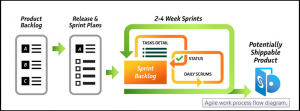At SAS, one of our core values is to be swift and agile. So it makes sense that our software development be Agile too. The Agile methodology has been around for more than 10 years and was designed with software development in mind. Today, it is still used predominately for this purpose, but is gaining momentum in other circles as well. In this Wall Street Journal article, parents even confess to bringing these ideas home and implementing Agile with their children.
Within SAS, divisions and teams use Agile in different ways; its nimbleness allows for varying degrees of adoption or implementation. For example, since 2008, R&D teams have been using Agile for requirements management, product implementation and project tracking. Planning is simplified with Agile. Potential product or solution features, known as stories, are ranked and scheduled in a release plan. Then they are assigned to an iteration or sprint (usually 2-4 weeks in length) in the development life cycle.
One of the main benefits of Agile development is that it fosters more cross-functional activity and collaboration, that is, a higher level of engagement and commitment. For example, for any given iteration, developers, testers and product managers work closely together and share updates several times a week in meetings called scrums. At the end of each iteration, all stakeholders sign off on features, and demos are given to internal or external stakeholders, showing the software in proper working condition.
Agile methodology was highlighted as a key development strategy at the Business Intelligence Development Roundtable at SAS Global Forum 2013. Business Intelligence R&D teams adopted Agile when they set out to create SAS’ data visualization software, SAS® Visual Analytics. Developing a new product like Visual Analytics required a nimble approach. Agile’s short, time-bound iterations allowed SAS product developers to incorporate user feedback more quickly and focus more on what worked.
In 2012, senior project managers at SAS surveyed SAS development teams to determine the effectiveness of Agile approaches. Seventy-eight percent of respondents said they would recommend Agile to another team. The survey reported that stronger adoption of Agile methods drives higher productivity and a deeper sense of engagement among teams.
In April 2013, Tim Arthur, Agile champion within SAS Research & Development, presented the results of that survey at the Stanford Strategic Execution Conference. Arthur heard from several Silicon Valley companies that SAS is ahead of the curve and viewed as a model for Agile adoption and scaling. If you're interested in learning more about SAS' approach, you can download Arthur's white paper Agile Adoption: Measuring its Worth.
Does your organization use Agile? Leave a comment to tell us about your experience or ask for more information about SAS' implementation of Agile.

